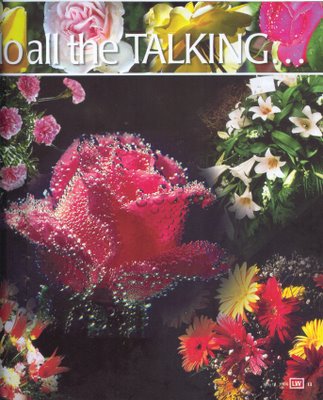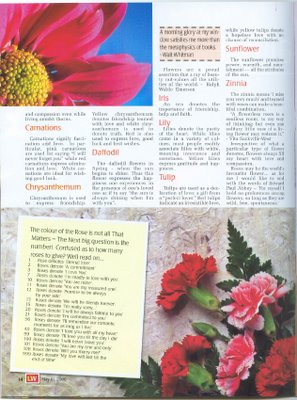(Published on 1 May 2006 in 'Lanka Woman' - Colombo, Sri Lanka)
At a loss for words… what better way to express your self than to say it with flowers. Flowers can express your emotions, thoughts, feelings and love for others better than anyone or anything else can ever do.
Many a beautiful story and legend is woven around flowers. According to a Roman legend, a number of suitors were keen on marrying a beautiful woman named Rodanthe, but she did not care for any of them. Despite her lack of interest, the suitors continued to woo Rodanthe so obsessively that they broke through the doors of her home. Angered by their actions and wanting to teach the suitors a lesson, the goddess Diana turned Rodanthe into a rose, and her suitors into thorns.
Another legend tells us that the Greek sun-god Helios. Helios was drowned by the Titans, and then raised to the sky, where he became the sun. He was loved by a mortal woman named Clytie, who died of her love for him. When she died she became a flower and followed Helios' daily journey through the sky. The sunflower's turning as it follows the sun symbolises her deep loyalty.
The Lotus is a very important symbol of Buddhism. It signifies the progress of the soul from the mud of materialism, through the waters of experience, and into the bright sunshine of enlightenment. An open blossom signifies full enlightenment; a closed blossom signifies the potential for enlightenment. That is why the Buddha sits on a lotus bloom. The colour of the lotus too has an important bearing. A white lotus represents the state of spiritual perfection and total mental purity. A red lotus signifies purity of the heart. It is the lotus of love, compassion, passion. A blue lotus is a symbol of the victory of the spirit over the senses, and signifies the wisdom of knowledge. A pink lotus is the supreme lotus, generally reserved for the highest deity, and thus associated with the Great Buddha.
Pink carnations have the most symbolic and historical significance. Carnations first appeared on Earth as Jesus carried the Cross. The Virgin Mary cried seeing Jesus suffer. And carnations sprang up from where her tears fell. Thus the pink carnation became the symbol of a mother's undying love and is now the emblem of Mother’s Day.
When you are in love the first thing that you think of is giving flowers to your loved one. There is a deep connection between flowers and love. Over a period of time, people have connected a specific meaning to each type of flower.
Flowers have spoken to me more than I can tell in written words. They are the hieroglyphics of angels, loved by all men for the beauty of the character, though few can decipher even fragments of their meaning. - Lydia M. Child
The world’s favourite – the rose
A rose is the most beautiful flower and no doubt everyone’s favourite. The name rose comes from the Latin word ‘rosa’, which means red. However, roses come in many different colours each of which have their own meaning. Exquisite and fragrant, the rose is the messenger of love. Besides, a rose teaches us life’s bitter lesson. It shows us how to stay beautiful and spread love and compassion even while living amidst thorns.
mRed roses - signify passion, romance and sensual love. Can also be given to convey congratulations on a job well done.
mPink roses - signify friendship, elegance and gentleness. Pink has long been associated with partnership and marriage.
mPeach roses - signify desire and excitement. The feelings expressed convey: anxious build up of love and a hurry to catch the romance.
mWhite roses - signify innocence and secrecy. The feelings expressed convey: purity and youthfulness.
mYellow roses - signify friendship, respect and gratitude. The feelings expressed convey: welcome back, remember me
mWhite and red roses together – signify unity.
mRed and yellow roses together - convey congratulations.
mYellow and orange roses together - imply passionate thoughts.
The colour of the rose is not all that matters – the next big question is the number! Confused as to how many roses to give - well read on.
1 rose denotes ‘Eternal love’
2 roses denote 'A commitment’
3 roses denote 'I Love You'.
7 roses denote 'I'm madly in love with you'.
10 roses denote 'You are mine'.
11 roses denote 'You are my treasured one'.
12 roses denote 'Promise to be always by your side'
13 roses denote 'We will be friends forever'.
15 roses denote 'I'm really sorry...'
20 roses denote 'I will be always faithful to you'
21 roses denote 'I'm committed to you'
36 roses denote 'I'll remember our romantic moments for as long as I live'
40 roses denote 'I love you with all my heart'
99 roses denote 'I'll love you till the day I die'
100 roses denote 'I will never leave you'
101 roses denote 'You are my one and only'
108 roses denote 'Will you marry me?'
999 roses denote 'My love will last till the end of time'
A morning glory at my window satisfies me more than the metaphysics of books. – Walt Whitman
Carnations
Carnations signify fascination and love. In particular, pink carnations are used for saying "I will never forget you" while red carnations express admiration and love. White carnations are ideal for wishing good luck.
Chrysanthemum
Chrysanthemum is used to express friendship. Yellow chrysanthemum denotes friendship teamed with love and white chrysanthemum is used to denote truth. Red is also used to express love, good luck and best wishes.
Daffodil
The daffodil flowers in Spring - when the sun begins to shine. Thus this flower expresses the happiness one experiences in the presence of one’s loved one as if to say “the sun is always shinning when I’m with you”.
Gladiolus
Gladioli denote sincerity. Derived from the Latin word meaning “sword”, it expresses infatuation, telling the receiver that he or she "pierces the heart like a sword would."
Flowers are a proud assertion that a ray of beauty out-values all the utilities of the world. - Ralph Waldo Emerson
Iris
An iris denotes the importance of friendship, help and faith.
Lily
Lilies denote the purity of the heart. While lilies come in a variety of colours, most people readily associate lilies with white, meaning innocence and sweetness. Yellow lilies express gratitude and happiness.
Tulip
Tulips are used as a declaration of love; a gift from a "perfect lover." Red tulips indicate an irresistible love, while yellow tulips denote a hopeless love with no chance of reconciliation.
Sunflower
The sunflower promises power, warmth, and nourishment — all the attributes of the sun.
Zinnia
The zinnia means 'I miss you very much' and teamed with roses can make a beautiful combination.
A flowerless room is a soulless room, to my way of thinking; but even one solitary little vase of a living flower may redeem it. - Vita Sackville-West
Irrespective of what a particular type of flower denotes – flowers always fill my heart with love and compassion. An offering of a flower at the altar seems like the ultimate expression of love and devotion for the Creator.
Roses may be the world’s favourite flower… as for me I would like to end with the words of Edward Paul Abbey – ‘For myself I hold no preferences among flowers, so long as they are wild, free, spontaneous.’
























